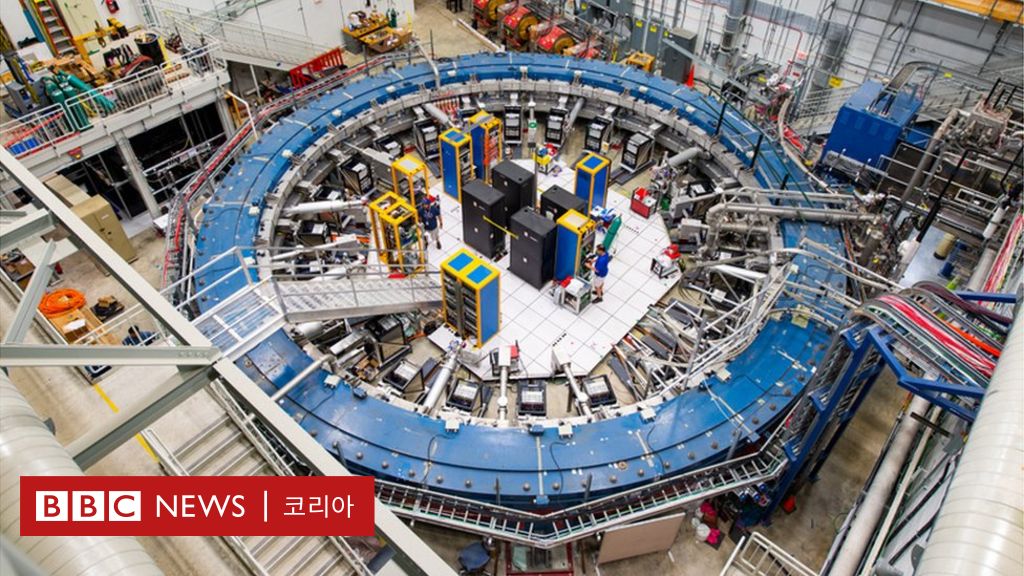
Photo Source, Reidar Hahn / FermiLab
Fermi National Accelerator Laboratory’s Muon g-2 experimental device
From attaching a magnet to a refrigerator door to throwing a ball into a hoop, the power of physics works at every moment in our lives.
Modern physics defines the basic forces that exist in the natural world, that is, all the forces we experience every day as gravity, electromagnetic force, force, and weak force.
But maybe now, physicists have discovered a fifth sign of force that needs to rewrite this definition.
The discovery came from a laboratory near Chicago, USA.
The four fundamental forces identified earlier control the way all objects and particles in the universe interact.
Gravity, for example, causes an object to fall to the ground and a heavy object to act as if it were attached to the floor.
The British Science and Technology Facilities Commission (STFC) said the findings “provide strong evidence for the existence of undiscovered sub-atomic particles or new forces.”
However, the results of this Muon g-2 experiment have not yet reached the level to be recognized as a new scientific discovery.
The probability that the current result is due to statistical error is 1 in 40,000, which corresponds to a statistical reliability of 4.1 sigma.
For a new discovery in physics, the probability of a statistical coincidence must be one in 3.5 million, or five sigma.
Professor Mark Lancaster of the University of Manchester, who participated in the experiment as a representative of the British research team, told the BBC “I found that the muon interactions do not match the standard model.”
The standard model is a theory that explains the composition and motion of the universe in modern physics.
Professor Lancaster said the discovery is “a very interesting discovery,” which suggests the possibility of “new laws of physics, particles, and new forces that we have never seen before.”
The findings are in line with the results of particle physics experiments in the United States, Japan, and, most recently, a large-scale particle collider across the borders of Switzerland and France.
“My instinctive sensations are telling the BBC that this is true,” said Ben Alanac, a professor at Cambridge University who was not involved in the experiment.
Batavia, near Chicago, Illinois, where the experiment took place
“I spent my career studying the forces and particles beyond the world as we know it. Now is the moment I discovered it, and I’m so excited that I can’t sleep.”
The study, conducted at the Fermi National Accelerator Laboratory in Batavia, Illinois, studied the swaying of subatomic particle muons to look for signs of new physical forces.
There are particles and subatoms smaller than atoms in the world. Some can decompose into smaller particles in the subatomic state, while some subatoms can no longer be decomposed.
Muons are classified as one of the basic particles that can no longer be split in a subatomic state.
Muons resemble electrons, but their mass is 200 times that of electrons.
The researchers who led the muon g-2 experiment put the muon in a 14m magnetic track and observed its movement in a magnetic field.
If he followed the modern laws of physics expressed through the standard model, the muon should have swayed by the predicted value.
However, the researchers found that the muon shakes faster than expected. This may mean that the muon is under the influence of a new force unknown to the scientific community.
Photo Source, Fermilab
Fermi National Accelerator Institute, America’s premier particle physics laboratory based on a 2700 hectare site near Chicago
No one yet knows how this new force works besides the effect on muon.
Physicists believe this may be related to subatoms that have not yet been discovered.
One or more possibilities have been proposed for what this virtual particle is.
One is likely to be a leptoquark, and the other is likely to be a Z’boson.
The physicists who participated in the LHCb experiment last month also suggested the possibility of new particles and forces.
“The race has really begun to get evidence that something new has been discovered,” said Dr Mittesh Patel of Imperial College London, who participated in the LHCb experiment at the time. I hope.”
Professor Alanac has given various names to this, which may be the fifth basic force in his theoretical model.
Among them are’flavour force’,’third hyper force’, and even ordinary’B minus L2′.
Photo Source, ESA/Hubble and NASA
There are still many mysteries in the universe that we cannot explain.
Subatomic particles are controlled by strong and weak forces, not gravitational and electromagnetic forces (the forces of electric and magnetic action), which are more familiar to us.
The Fifth Basic Force could help solve some of the big riddles about the universe that have left scientists questionable in recent decades.
For example, the observation that the expansion of the universe is accelerating is due to a mysterious phenomenon known as dark energy.
However, some scholars in the past have suggested that this may be evidence of the fifth power.
“It’s amazing. This discovery has the potential to overturn physics,” said Dr. Maggie Aderine Pocock, co-host of BBC’The Sky at Night’. Discovery can give us key answers to these riddles.”
